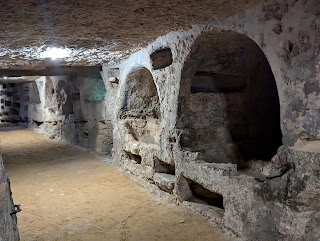After touring Sicily's northern Tyrrhenian coast and most of the eastern coast, Steven and I arrived in Siracusa on the southeastern part of the island. A travel writer penned that "... to experience Sicily at its most beautiful, ... explore (this portion of the island for) stunning Baroque-style towns that seem to glow in the evening sun, unspoiled beaches where you can swim almost all year round, and hidden hillsides full of olive groves and wild herbs." We'd already discovered spectacularly beautiful areas of the island, so we'd be hard-pressed in my mind to discover "the most beautiful" part in the southeast in the ensuing days.
Before planning the Sicily segment of our fall trip, I hadn't known that Siracusa, or Syracuse to its English speakers, was one of the great ancient capitals of Western civilization. Founded in 734 BC by colonists from Corinth, Greece, it soon rivaled and even overshadowed Athens in power and grandeur. Siracusa became the West's largest and wealthiest city-state and the epitome of Greek civilization. The most highly cultured Greeks - among them, the philosopher Plato and playwrights Euripides and Aeschylus - made their homes there. Athenians, jealous of Siracusa's prominence, sought to conquer it but failed in one of the ancient world's greatest military campaigns in 413 BC. The Romans, however, successfully conquered the prosperous city-state two centuries later.
As Siracusa is most renowned for its dramatic Greek and Roman ruins, we headed first to the Parco Archeologico della Neapolis, considered by many to be some of the best archaeology sites in all of Italy.
The Grotticelle Necropolis, overlooking the theater, was the site of the first burials, which began in the Bronze Age but peaked in the 3rd century BC.
I Googled the necropolis site to learn that the limestone necropolis's rock face featured niches and votive squares, where objects such as tablets, paintings, and epitaphs were placed.
Among huge boulders triggered by the collapse of the enormous stone quarry vault centuries ago were sculptures of the three faces and three bodies of Ikaro.
The broken face of the Iron Shadows sculpture rested on stone and was surrounded by stone in a large niche. Its purpose was to remind viewers of the harsh reality in the quarry, which was a theater of captivity and labor for the Greeks as they built Siracusa.
The famous Orecchio di Dionisio was an artificial cave with an ear-shaped entrance named by the famous Italian painter Caravaggio. Initially, there appeared to be nothing inside the dark cave until we saw another amazing sculpture deep inside. The cave had unusual acoustics, which we noticed when people clapped their hands. The legend is that Dionysius used to listen at the top of the quarry to hear what the enslaved Athenians were plotting below.
Looking at the well-preserved Roman Amphitheater, which was largely in its natural state, it was much easier to imagine it in Roman times, except for the Eros Blindfolded sculpture! The Roman arena was built around the 2nd century AD and is one of the largest of its kind.
The Catacomba di San Giovanni, one of the earliest known Christian sites in Siracusa, was not far from the archaeological park. Arriving by ship from the East, Christians founded in Siracusa one of the largest communities in the Western world announcing the Gospel through words, but above all, through images. Over time, they compressed the mythical elements already present in pagan Greek culture and added new truths about faith, giving life to new religious symbols and even new images of God.
St. Marciano, who founded the oldest Christian community in the Western world in 39 AD, is said to have prepared the ideal conditions for welcoming the Apostle Paul, who arrived in Siracusa in 61 AD. Through a passage dug into the rock behind the Basilica, we entered the main gallery of the Catacombs, a tunnel almost one hundred meters long with walls dotted with small burial niches.
The guide informed us that the faces had been blacked out because they couldn't celebrate their Christian faith.
A faint depiction of a peacock on the fresco represented eternal life.
The most captivating aspect for me as a visitor was that the sacred stones in the catacombs represented the evangelization of Sicily, thereby making the crypt an important point of reference for the entire Western Christian world. Caravaggio, during his brief stop in Syracuse, spent time in the catacombs, which later influenced his paintings.
Steven and I had hoped to then visit the island of Ortigia, the ancient city first inhabited by Greeks, which was connected to the mainland by two small bridges in the Ionian Sea. Unfortunately, the bridges were closed to cars that Saturday because, we suspected, too many cars were there already.

























































Absolutely captivating step back in time...gladiator sites, catacombs, ancient Christmas scene. What a remarkable walk through ancient history. Thank you. xo Lina in Tremblant xo
ReplyDeleteIf you and Dan are ever lucky enough to visit Sicily, you'd love Siracusa, Lina, for the reasons you mentioned! Enjoy magical Tremblant.
DeleteI remember visiting this place many years ago with my Sicilian heritage husband. It is interesting that it is of Greek origin. And, yes, the cave does echo well. JDK
ReplyDeleteHope the text and photos brought back happy memories of your time in Siracusa with Pat, Janina.
ReplyDelete